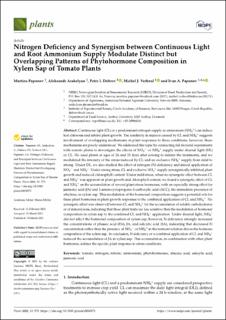| dc.description.abstract | Continuous light (CL) or a predominant nitrogen supply as ammonium (NH4+) can induce leaf chlorosis and inhibit plant growth. The similarity in injuries caused by CL and NH4+ suggests involvement of overlapping mechanisms in plant responses to these conditions; however, these mechanisms are poorly understood. We addressed this topic by conducting full factorial experiments with tomato plants to investigate the effects of NO3− or NH4+ supply under diurnal light (DL) or CL. We used plants at ages of 26 and 15 days after sowing to initiate the treatments, and we modulated the intensity of the stress induced by CL and an exclusive NH4+ supply from mild to strong. Under DL, we also studied the effect of nitrogen (N) deficiency and mixed application of NO3− and NH4+. Under strong stress, CL and exclusive NH4+ supply synergistically inhibited plant growth and reduced chlorophyll content. Under mild stress, when no synergetic effect between CL and NH4+ was apparent on plant growth and chlorophyll content, we found a synergetic effect of CL and NH4+ on the accumulation of several plant stress hormones, with an especially strong effect for jasmonic acid (JA) and 1-aminocyclopropane-1-carboxylic acid (ACC), the immediate precursor of ethylene, in xylem sap. This modulation of the hormonal composition suggests a potential role for these plant hormones in plant growth responses to the combined application of CL and NH4+. No synergetic effect was observed between CL and NH4+ for the accumulation of soluble carbohydrates or of mineral ions, indicating that these plant traits are less sensitive than the modulation of hormonal composition in xylem sap to the combined CL and NH4+ application. Under diurnal light, NH4+ did not affect the hormonal composition of xylem sap; however, N deficiency strongly increased the concentrations of phaseic acid (PA), JA, and salicylic acid (SA), indicating that decreased N concentration rather than the presence of NO3− or NH4+ in the nutrient solution drives the hormone composition of the xylem sap. In conclusion, N deficiency or a combined application of CL and NH4+ induced the accumulation of JA in xylem sap. This accumulation, in combination with other plant hormones, defines the specific plant response to stress conditions. | en_US |

